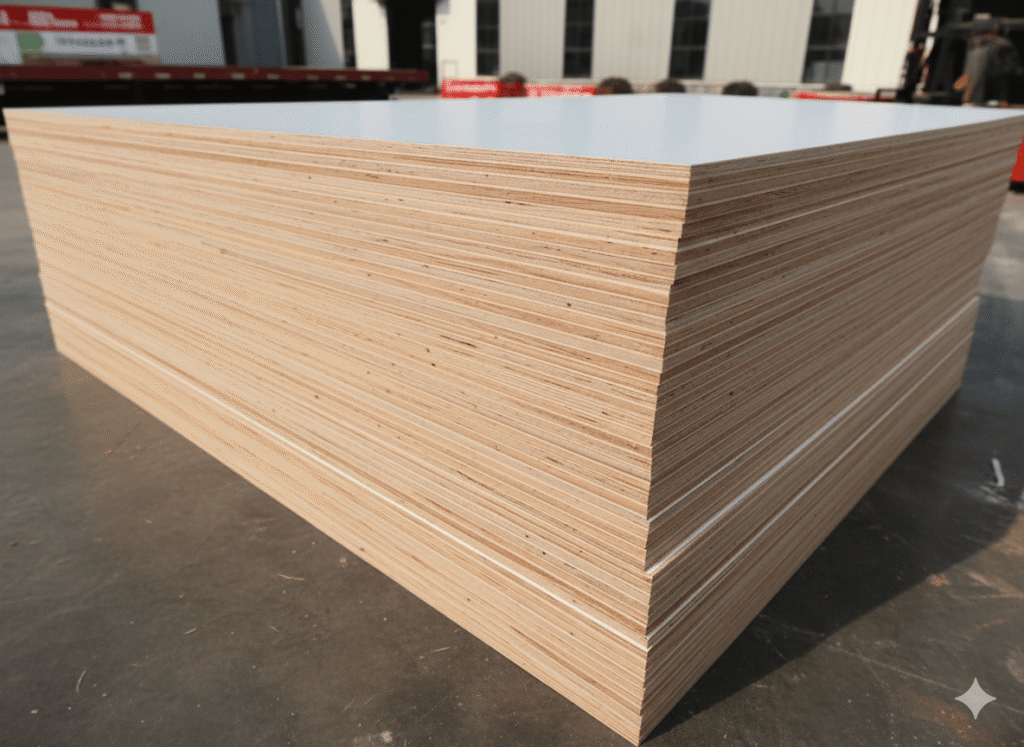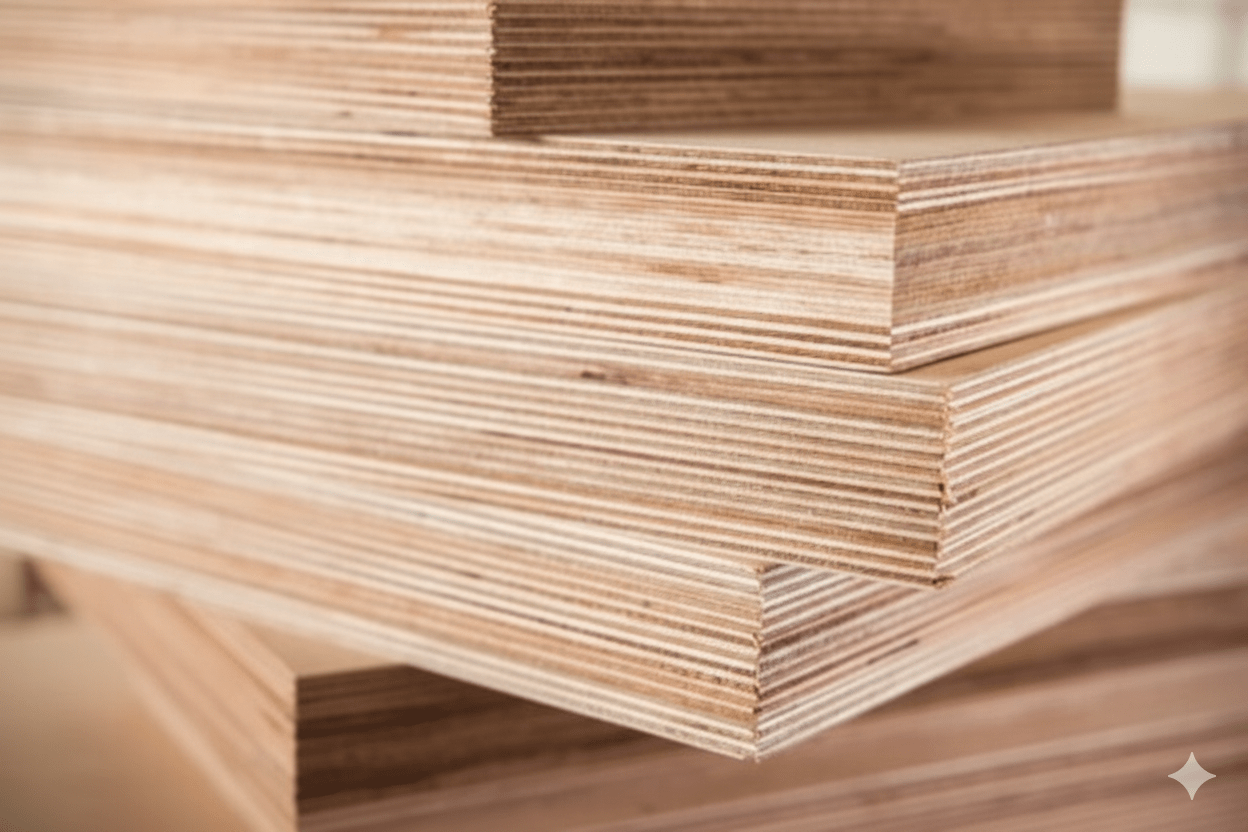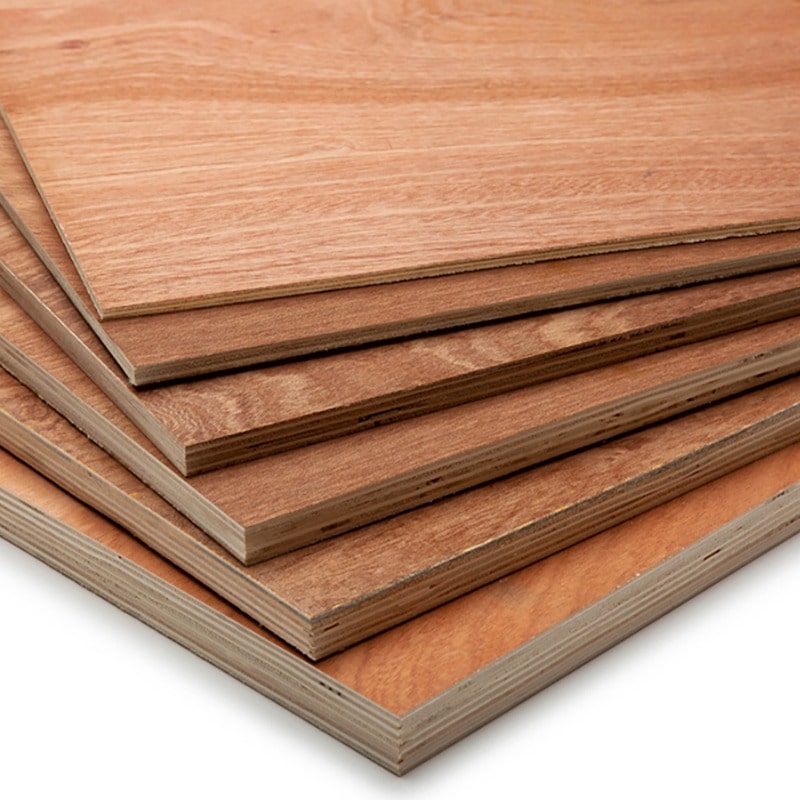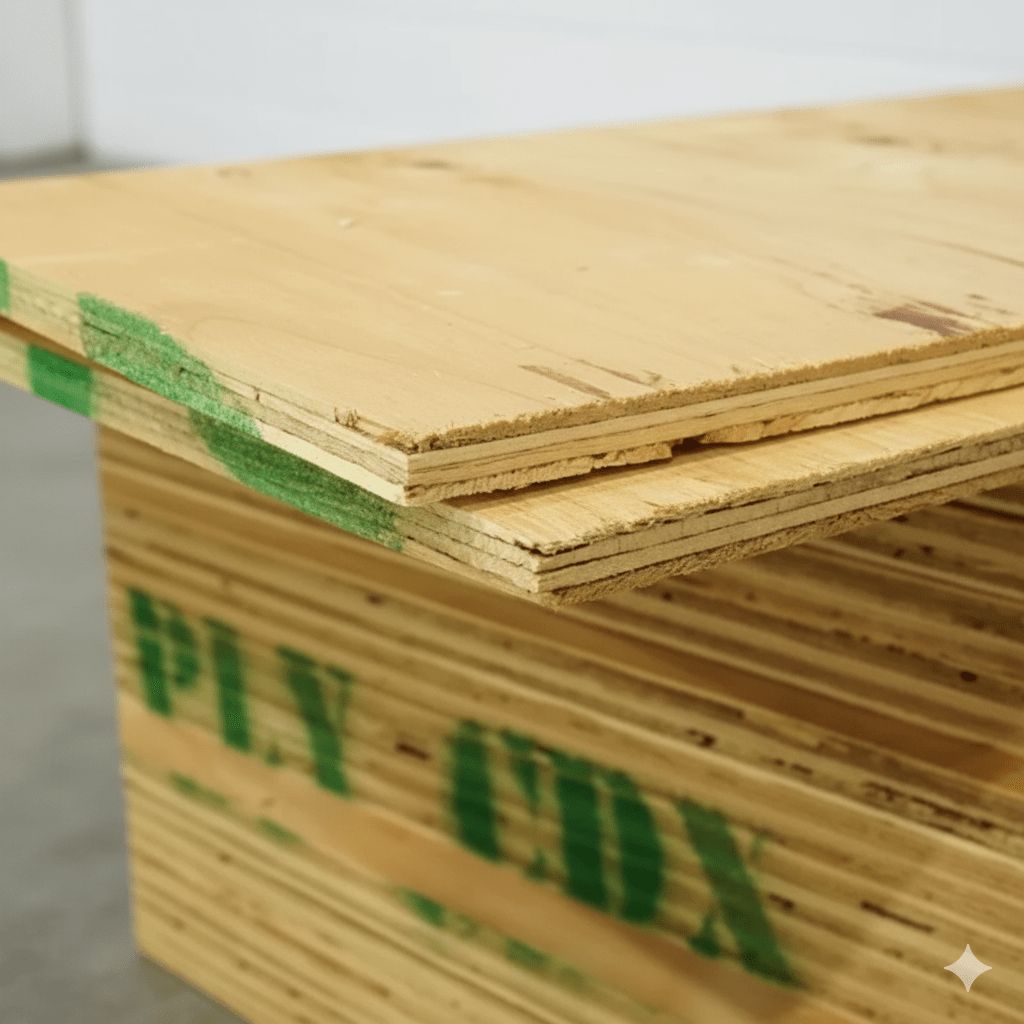Figuring out which plywood works best for an attic floor isn’t as simple as grabbing the cheapest sheet at the store.
Attics deal with weight, shifting temperatures, and sometimes a bit of moisture, so the type you choose really matters.
We’ll run through six common types of plywood for attic floor projects – what they’re good at, where they fall short, and how to decide which makes sense for your space.
Our Top 3 Picks
1. Basic Plywood

Basic plywood is the go-to option for most attic flooring projects. Built from thin layers of wood veneer pressed together at alternating grain directions, it’s strong, stable, and less prone to warping than solid wood.
For homeowners, that means a floor that can handle the weight of boxes, bins, or even light living space conversions without buckling under pressure.
With 3/4-inch sheets laid securely across joists, you’re looking at a dependable, budget-friendly choice that gets the job done.
Features
- Available in 1/2″ to 3/4″ thickness (3/4″ recommended for storage or heavier loads)
- Tongue-and-groove options interlock to reduce movement and gaps
- Sold in standard 4’x8’ sheets, but can be cut smaller for attic access
- Can be sealed or painted for added protection against moisture
Pros
- Strong and durable, ideal for storage or occasional use rooms
- Cost-effective and widely available at building supply stores
- Straightforward to cut, fit, and install
- Weight distributes evenly across joists
- Can be finished to improve aesthetics and protection
Cons
- Heavier than some alternatives – weight may be a concern in older attics
- Lower-grade plywood can have surface defects or reduced durability
- Susceptible to moisture absorption if left unfinished
- Requires precise installation so panels sit squarely on joists
2. Structural Plywood

If your attic will see more than just the occasional holiday box drop-off, structural plywood is a smart upgrade.
Built from multiple cross-laminated veneer layers, it’s engineered for strength and stability, giving it the muscle to handle heavier storage, foot traffic, or even a full attic conversion.
Its resistance to splitting and warping also makes it more reliable than particleboard or lower-grade sheet goods.
Features
- Cross-laminated veneer layers provide superior strength and stability
- Available in common thicknesses from 1/2″ to 3/4″
- Can be used as subflooring for finished attic rooms or as standalone storage flooring
- Moisture- and temperature-resistant when treated or marine grade
- Installs easily in large panels and fastens securely to joists
Pros
- Strong, durable, and stable under heavy loads
- More affordable than solid wood but highly resilient
- Handles weight and traffic better than particleboard
- Resists splitting, cracking, and warping
- Versatile enough for both storage and living space use
- Simple to cut and install
Cons
- Requires properly sized and spaced joists for safe installation
- Untreated versions can degrade with prolonged moisture exposure
- Heavier than some engineered wood alternatives
- May need sealing or added moisture protection in damp environments
3. Marine Plywood

If your attic has a history of humidity or you’re simply looking for the most durable option, marine plywood is hard to beat.
Built with waterproof adhesive and multiple cross-laminated veneers, it’s designed to resist moisture, rot, and fungal growth.
While often used in boats or outdoor projects, its strength and stability make it a premium choice for attic flooring where long-term performance matters.
Features
- Constructed with waterproof adhesives (phenolic or melamine)
- Multiple cross-laminated veneers for strength and dimensional stability
- Graded for bond strength, appearance, and defect resistance
- Smooth, sanded surfaces that take paint well
- Available in 1/2″ to 3/4″ (3/4″ recommended for attic flooring)
Pros
- Exceptional moisture resistance prevents warping, rotting, and mold
- Stronger and more durable than standard plywood
- Excellent screw-holding capacity and impact resistance
- Stable under fluctuating climate conditions
- Long lifespan when properly installed and sealed
Cons
- More expensive than standard plywood or OSB
- Heavier weight makes handling and installation harder
- May contain chemicals unless sourced with low-VOC certification
- Overkill in dry, well-ventilated attics where basic plywood would suffice
4. Hardwood Plywood

Hardwood plywood brings both strength and style to attic floors. Built from multiple thin hardwood veneers glued in alternating grain patterns, it offers the durability of natural hardwood while being lighter and easier to work with.
Its attractive surface finish also makes it a strong candidate for attics that might eventually be converted into living spaces, where appearance matters as much as strength.
Features
- Multiple layers of hardwood veneers bonded with strong adhesives
- Face layer showcases natural hardwood grain for aesthetics
- Smooth surface ready for staining, sealing, or finishing
- Available in 3/4″ thickness, ideal for attic flooring
- Stable against moderate temperature and moisture fluctuations
Pros
- Strong load-bearing capacity for heavy storage or traffic
- More dimensionally stable than solid wood, less prone to warping
- Attractive natural grain finish suitable for living space conversions
- Can be refinished or sealed for extended durability
- Easier to install than solid hardwood planks
- Eco-friendly options available with low-VOC adhesives
Cons
- More expensive than softwood plywood or OSB alternatives
- Requires proper ventilation and moisture management
- Not fully waterproof; humidity can cause swelling if untreated
- Heavier than engineered wood alternatives like OSB
- Finishing for aesthetics may require higher skill or extra time
5. CDX Plywood

CDX plywood is one of the most widely used choices for attic flooring – and for good reason.
Built with multiple veneer layers and exterior-grade adhesive, it delivers the strength and durability needed to support heavy storage while standing up to the temperature swings and occasional humidity of an attic.
It may not win style points with its rough surface, but for functionality at a fair price, it’s tough to beat.
Features
- Constructed with cross-laminated veneers and exterior-grade adhesive
- “C” grade front, “D” grade back, with imperfections acceptable for structural use
- Typically 5/8″ to 3/4″ thick for attic flooring strength
- Moisture resistant (but not fully waterproof)
- Comes in 4-ply panels, easy to cut and install
Pros
- High load-bearing capacity, ideal for attic storage
- Exterior-grade adhesive resists moisture and prevents delamination
- Long-lasting durability (20–40 years with proper care)
- Affordable compared to higher-grade plywood types
- Readily available and easy to work with
- Stable surface reduces sagging or twisting over time
Cons
- Rough, unfinished surface with visible knots and imperfections
- Not suitable for decorative or exposed flooring
- Heavier than some alternatives like OSB
- Must be nailed or screwed securely; poor installation can lead to instability
- Edges require proper support to prevent slipping or cracking
6. Tongue-and-Groove Plywood

Tongue-and-groove (T&G) plywood takes attic flooring a step further by locking panels tightly together for a seamless, stable surface.
With one side cut as a tongue and the other as a groove, each sheet interlocks to minimize gaps, creaks, and shifting. The result is a rigid, long-lasting floor that feels solid underfoot – a big advantage if your attic will see frequent traffic or heavier storage.
Features
- Interlocking tongue-and-groove edges for a tight fit
- Even load distribution across joists for stability
- Minimizes panel movement and reduces squeaks
- Smooth, uniform surface suitable for storage or finishing
- Compatible with glue, nails, or screws for extra strength
Pros
- Enhanced stability with reduced sagging and bouncing
- Quieter floor thanks to tighter joints and less shifting
- Durable engineered construction resists warping or bending
- Streamlined installation with easier sheet alignment
- Provides a more seamless, finished look than flat-edge plywood
- Versatile for use beyond attic floors (roof decking, wall sheathing, etc.)
Cons
- Installation can be tricky – requires careful alignment of joints
- Not waterproof, and still needs sealing in humid environments
- More expensive than standard flat-edge plywood
- Less forgiving on uneven joists; subfloor must be level
- Cutting or trimming panels can damage the tongue-and-groove edges
Comparison: Types of Plywood for Attic Floors
| Decision Criteria | Basic Plywood | Structural Plywood | Marine Plywood | Hardwood Plywood | CDX Plywood | T&G Plywood |
|---|---|---|---|---|---|---|
| Budget-friendly | ✔️ | ✔️ | ❌ | ❌ | ✔️ | ❌ |
| High moisture resistance out of the box | ❌ | ❌ | ✔️ | ❌ | ❌ | ❌ |
| Suited to humid/ condensation prone attics | ❌ | ❌ | ✔️ | ❌ | ❌ | ❌ |
| Finish-ready surface for visible flooring | ❌ | ❌ | ✔️ | ✔️ | ❌ | ✔️ |
| Smooth surface that paints well | ✔️ | ❌ | ✔️ | ✔️ | ❌ | ✔️ |
| Reduced squeaks underfoot | ❌ | ❌ | ❌ | ❌ | ❌ | ✔️ |
| DIY-friendly install | ✔️ | ✔️ | ❌ | ✔️ | ✔️ | ❌ |
| Widely available at big-box stores | ✔️ | ✔️ | ❌ | ✔️ | ✔️ | ✔️ |
| Strong for heavy storage loads | ✔️ | ✔️ | ✔️ | ✔️ | ✔️ | ✔️ |
| Good for future living space conversion | ❌ | ✔️ | ✔️ | ✔️ | ❌ | ✔️ |
How to Choose the Best Plywood for an Attic Floor
Attics are a tricky environment – temperature swings, possible moisture, and the weight of whatever you decide to store up there all come into play.
Here are the main criteria to keep in mind and how the different plywood options stack up:
1. Load-Bearing Capacity
Attic flooring must support both storage and occasional foot traffic, and if you’re planning to turn the space into a livable area, the demands are even higher.
A 3/4-inch thickness is the standard recommendation.
- Best choices: Structural plywood, CDX plywood, and T&G plywood all excel here, offering reliable strength and stability under heavy loads.
- Less ideal: Basic plywood works fine for lighter storage but may flex under heavier weight if joists are widely spaced.
2. Moisture Resistance
Attics are notorious for humidity and condensation, so resistance to moisture is key to preventing warping or rot.
- Best choices: Marine plywood is the gold standard, specifically built to handle wet or damp environments. Hardwood plywood also offers moderate resistance, provided it’s sealed.
- Less ideal: Basic and CDX plywood are moisture-resistant to a point but not waterproof. They need sealing in humid climates to last.
3. Durability and Stability
The layered construction of plywood already provides solid dimensional stability, but some grades perform better than others in resisting warping and movement.
- Best choices: Structural plywood is engineered for maximum stability. T&G plywood also shines here, with its interlocking design that minimizes squeaks and panel movement.
- Less ideal: Lower-grade basic plywood can develop surface defects and warp faster if exposed to attic moisture.
4. Ease of Installation
Ease of installation can make or break an attic flooring project, especially in tight or awkward spaces.
- Best choices: Basic plywood and CDX plywood are straightforward to cut and install, making them DIY-friendly.
- Trickier options: Marine plywood is heavier and harder to maneuver. T&G plywood, while stable, requires careful alignment, which can slow things down.
5. Cost
Budget plays a big role in attic projects, and plywood prices vary widely based on grade and performance.
- Best value: Basic plywood and CDX plywood offer the most affordable solutions without sacrificing too much in performance.
- Higher investment: Marine and hardwood plywood are at the premium end – excellent choices when aesthetics or moisture protection are priorities but not always necessary for simple storage floors.
Bottom Line:
For most attics, CDX or structural plywood at 3/4-inch thickness strikes the best balance of cost, strength, and ease of use.
If moisture is a real concern, marine plywood is worth the extra spend.
For long-term conversions into living space, hardwood or T&G plywood provide the durability and finish quality to match the investment.
Frequently Asked Questions
Can I use OSB instead of plywood for an attic floor?
Yes, OSB (oriented strand board) can be used, but plywood is generally stronger, more stable under load, and less prone to edge swelling if moisture gets in. For long-term durability, plywood is usually the safer bet.
Do I need insulation under attic flooring plywood?
It depends on your attic setup. If the attic is above living space, insulation is recommended to improve energy efficiency. Just make sure airflow isn’t blocked and any insulation is installed according to code.
What’s the minimum thickness plywood I can use for an attic floor?
While 1/2-inch plywood might work for very light storage and close joist spacing, 3/4-inch is typically recommended for safe load-bearing and long-term stability.
Should attic plywood be treated or sealed?
Sealing is a good idea, especially in humid climates. A clear sealant or paint can add protection against moisture and extend the lifespan of the floor without adding much cost.
Conclusion
At the end of the day, choosing plywood for attic floor projects isn’t one-size-fits-all.
Some people just need a sturdy surface for storage, where CDX or basic plywood makes sense. Others want extra stability or a tighter fit, which is where structural or tongue-and-groove comes in. If moisture’s a concern, marine plywood is the safe bet, while hardwood plywood is better if you’re eyeing a future living space.
The key is matching thickness and type to how you’ll use the attic.Thinking about something more finished than plywood? Book a free in-home appointment – we’ll bring hardwood samples, walk you through pricing, and help you figure out what fits best.

